Antibody data
- Antibody Data
- Antigen structure
- References [3]
- Comments [0]
- Validations
- Western blot [1]
- Immunocytochemistry [1]
- Immunoprecipitation [1]
- Immunohistochemistry [2]
- Flow cytometry [1]
Submit
Validation data
Reference
Comment
Report error
- Product number
- 13996-1-AP - Provider product page

- Provider
- Proteintech Group
- Proper citation
- Proteintech Cat#13996-1-AP, RRID:AB_2159779
- Product name
- PARD6B antibody
- Antibody type
- Polyclonal
- Description
- PARD6B antibody (Cat. #13996-1-AP) is a rabbit polyclonal antibody that shows reactivity with human, mouse, rat and has been validated for the following applications: FC, IF, IHC, IP, WB,ELISA.
- Reactivity
- Human, Mouse, Rat
- Host
- Rabbit
- Conjugate
- Unconjugated
- Isotype
- IgG
- Vial size
- 20ul, 150ul
Submitted references Induced retinal pigment epithelial cells with anti-epithelial-to-mesenchymal transition ability delay retinal degeneration.
PKCζ and JNK signaling regulate radiation-induced compensatory proliferation in parotid salivary glands.
Influence of Wilms' tumor suppressor gene WT1 on bovine Sertoli cells polarity and tight junctions via non-canonical WNT signaling pathway.
Tian H, Chen Z, Zhu X, Ou Q, Wang Z, Wu B, Xu JY, Jin C, Gao F, Wang J, Zhang J, Zhang J, Lu L, Xu GT
iScience 2022 Oct 21;25(10):105050
iScience 2022 Oct 21;25(10):105050
PKCζ and JNK signaling regulate radiation-induced compensatory proliferation in parotid salivary glands.
Wong WY, Allie S, Limesand KH
PloS one 2019;14(7):e0219572
PloS one 2019;14(7):e0219572
Influence of Wilms' tumor suppressor gene WT1 on bovine Sertoli cells polarity and tight junctions via non-canonical WNT signaling pathway.
Wang X, Adegoke EO, Ma M, Huang F, Zhang H, Adeniran SO, Zheng P, Zhang G
Theriogenology 2019 Oct 15;138:84-93
Theriogenology 2019 Oct 15;138:84-93
No comments: Submit comment
Supportive validation
- Submitted by
- Proteintech Group (provider)
- Main image

- Experimental details
- HeLa cells were subjected to SDS PAGE followed by western blot with 13996-1-AP(PARD6B antibody) at dilution of 1:500
- Sample type
- cell line
Supportive validation
- Submitted by
- Proteintech Group (provider)
- Main image
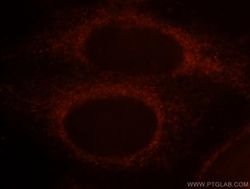
- Experimental details
- Immunofluorescent analysis of HepG2 cells, using PARD6B antibody 13996-1-AP at 1:25 dilution and Rhodamine-labeled goat anti-rabbit IgG (red).
- Sample type
- cell line
Supportive validation
- Submitted by
- Proteintech Group (provider)
- Main image
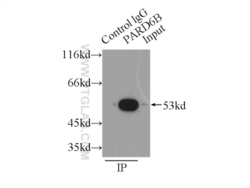
- Experimental details
- IP Result of anti-PARD6B (IP:13996-1-AP, 3ug; Detection:13996-1-AP 1:200) with HEK-293 cells lysate 6000ug.
- Sample type
- cell line
Supportive validation
- Submitted by
- Proteintech Group (provider)
- Main image
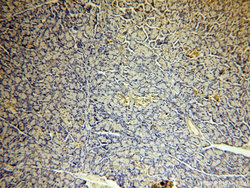
- Experimental details
- Immunohistochemical of paraffin-embedded human pancreas using 13996-1-AP(PARD6B antibody) at dilution of 1:100 (under 10x lens)
- Sample type
- tissue
- Submitted by
- Proteintech Group (provider)
- Main image
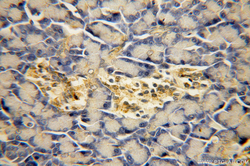
- Experimental details
- Immunohistochemical of paraffin-embedded human pancreas using 13996-1-AP(PARD6B antibody) at dilution of 1:100 (under 40x lens)
- Sample type
- tissue
Supportive validation
- Submitted by
- Proteintech Group (provider)
- Main image
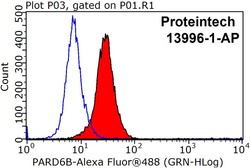
- Experimental details
- The PARD6B antibody from Proteintech is a rabbit polyclonal antibody to a recombinant protein of human PARD6B. This antibody recognizes human,mouse,rat antigen. The PARD6B antibody has been validated for the following applications: ELISA, WB, IHC, IF, IP, FC analysis.
 Explore
Explore Validate
Validate Learn
Learn Western blot
Western blot ELISA
ELISA